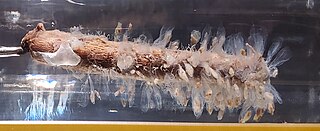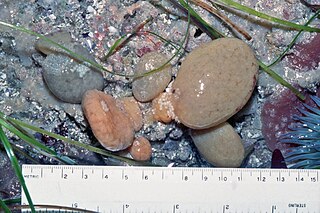
A tunicate is a marine invertebrate animal, a member of the subphylum Tunicata. It is part of the Chordata, a phylum which includes all animals with dorsal nerve cords and notochords. The subphylum was at one time called Urochordata, and the term urochordates is still sometimes used for these animals. They are the only chordates that have lost their myomeric segmentation, with the possible exception of the 'seriation of the gill slits'. However, doliolids still display segmentation of the muscle bands.

Ascidiacea, commonly known as the ascidians or sea squirts, is a paraphyletic class in the subphylum Tunicata of sac-like marine invertebrate filter feeders. Ascidians are characterized by a tough outer "tunic" made of a polysaccharide.

Trabectedin, sold under the brand name Yondelis, is an antitumor chemotherapy medication for the treatment of advanced soft-tissue sarcoma and ovarian cancer.

Botrylloides leachii is a colonial tunicate of the family Styelidae. Its unique methods of propagation and regeneration make it an ideal model organism for use in biological study of development, immunology, stem cells, and regeneration.

Perophora is a sea squirt genus in the family Perophoridae. Most species are found in shallow warm water but a few are found in higher latitudes. A colony consists of a number of zooids which bud off from a long slender stolon.

Atriolum robustum is a colonial tunicate or sea squirt in the family Didemnidae. It is native to the western and central Indo-Pacific where it is usually found anchored to a hard surface in shallow water.
Maritigrella crozierae, the tiger flatworm, is a species of marine polyclad flatworm in the family Euryleptidae. It is found on the eastern coasts of North America and the Caribbean Sea where it feeds on colonial sea squirts.

Didemnum molle is a species of colonial tunicate in the family Didemnidae. It is commonly known as the tall urn ascidian, the green barrel sea squirt or the green reef sea-squirt. It is native to the Red Sea and the tropical waters of the Indo-Pacific region.

Didemnum vexillum is a species of colonial tunicate in the family Didemnidae. It is commonly called sea vomit, marine vomit, pancake batter tunicate, or carpet sea squirt. It is thought to be native to Japan, but it has been reported as an invasive species in a number of places in Europe, North America and New Zealand. It is sometimes given the nickname "D. vex" because of the vexing way in which it dominates marine ecosystems when introduced into new locations, however the species epithet vexillum actually derives from the Latin word for flag, and the species was so named because of the way colonies' long tendrils appear to wave in the water like a flag.
Perophora viridis, the honeysuckle tunicate, is a species of colonial sea squirt in the genus Perophora found in the tropical western Atlantic Ocean.
Amathia vidovici is a species of colonial bryozoans with a tree-like structure. It is found in shallow waters over a wide geographical range, being found in both the Atlantic and Pacific Oceans and adjoining seas.
Amathia verticillata, commonly known as the spaghetti bryozoan, is a species of colonial bryozoans with a bush-like structure. It is found in shallow temperate and warm waters in the western Atlantic Ocean and the Caribbean Sea and has spread worldwide as a fouling organism. It is regarded as an invasive species in some countries.

Perophora regina is a species of colonial sea squirt in the genus Perophora. It is native to the tropical western Atlantic Ocean where it is found growing on mangrove roots on the Belize Barrier Reef.
Perophora multiclathrata is a species of colonial sea squirt in the genus Perophora. It is native to the tropical Indo-Pacific and the western Atlantic Ocean.

Polyclinum planum is a compound ascidian commonly known as the elephant ear tunicate. It is an ascidian tunicate in the family Polyclinidae. Ascidians are also known as sea squirts.
Polyandrocarpa is a genus of ascidian tunicates within the family Styelidae.

Dendrodoa grossularia is a species of tunicate or sea squirt in the family Styelidae, commonly known as the baked bean ascidian. It is native to the northeastern Atlantic Ocean where it is common in shallow water and on the lower shore in exposed rocky sites.
Stolonica socialis is a species of tunicate or sea squirt in the family Styelidae, commonly known as orange sea grapes. It is native to the northeastern Atlantic Ocean, where it lives on the rocky seabed in shallow water.

Distomus variolosus is a species of tunicate or sea squirt in the family Styelidae. It is native to the northeastern Atlantic Ocean where it lives on the seabed, typically on the stems and fronds of kelp.

Aplidium elegans, the sea-strawberry, is a species of colonial sea squirt, a tunicate that is a benthic invertebrate in the family Polyclinidae and class Ascidiacea. It is native to shallow waters in the Atlantic Ocean and Mediterranean Sea. It is also found in between France and the United Kingdom.














